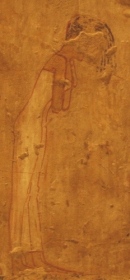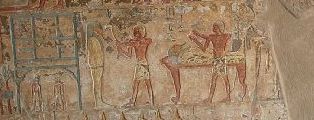The Hair and the Eye of Horus.

Detail of the mourners covering their faces with the hair. Tomb of Rekhmire in Gourna. XVIII Dynasty. Photo: Mª Rosa Valdesogo
The hair sm3 is assimilated to the lunar eye’s disease. The damage eye of Horus is an image of the battle between him and Seth, the Osiris’ murderer and in the Egyptian belief it symbolises the chaos and the darkness of the death. It is the moment the mourners are in nwn gesture and covering their faces with their hair sm3.
For the deceased’s rebirth it is necessary the healing of this lunar eye. In the mythic sphere is Thoth who spits on the eye for eliminating the disease it suffers, in the funerary ceremony we do not know if someone spitted on the mourner’s hair sm3.
Once the eye is recovered it becomes the Udjat eye. For contributing to the final resurrection the Udjat eye is offered to Osiris, this action symbolises the access from darkness to light.
In the funerary context it is the step from the hair sm3, image of chaos, darkness, evil, to the hair s3mt, assimilated to the Udjat eye. According to the funerary texts it is the moment of cutting the s3mt, something that can be understood as shaving the mourners and ending the mourning ritual.
The Hair and the Opening of the Mouth Ceremony.

On the right the mourner in nwn gesture towards the corpse. Scene from the tomb of Renni in el-Kab. XVIII Dynasty. Photo: http://www.osirisnet.net
The mourning ritual was one of the several sacred practices which formed the Opening of the Mouth ceremony. The two Drt, or two kites, maybe were professional and expert priestess who knew quite well this secret ritual of the resurrection. They shook (nwn) and/or pulled (nwn m) their hair towards the corpse dramatizing this way the passage in the Osiris’ legend, where Isis and Nephtys mourned his death, helped in his body recovery and contributed in his final rebirth.
Probably the mourning ritual started before the sacrifice of an ox. After a while hair started the slaughter of the animal while the mourners went on making the nwn gesture. The ox was the scapegoat and its death symbolised the victory of Horus over Seth, and the recovery of the Udjat eye. The female nature of these two women was crucial thanks to the relationship of women to moon and light.

Sacrifice of the ox with the presence of the mourner. Painting from the tomb of Rekhmire in Gourna. XVIII Dynasty. Photo: Mª Rosa Valdesogo Martín.
It is not clear if the mourning ritual was done before or after the tekenu rite, but in both cases the hair had a relevant role, because it seems that at the end a piece of hair was cut and offered to the deceased for his benefit and for contributing to his final resurrection.




